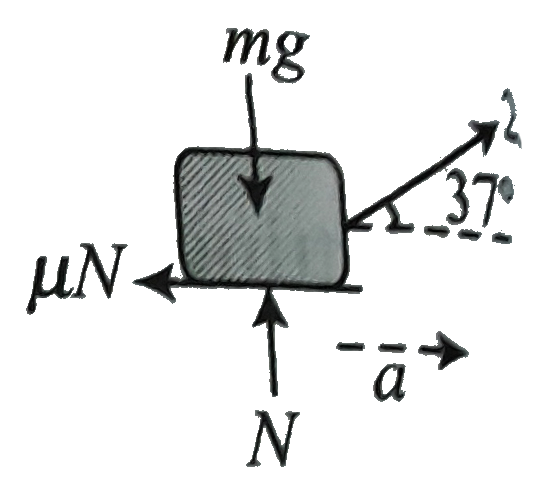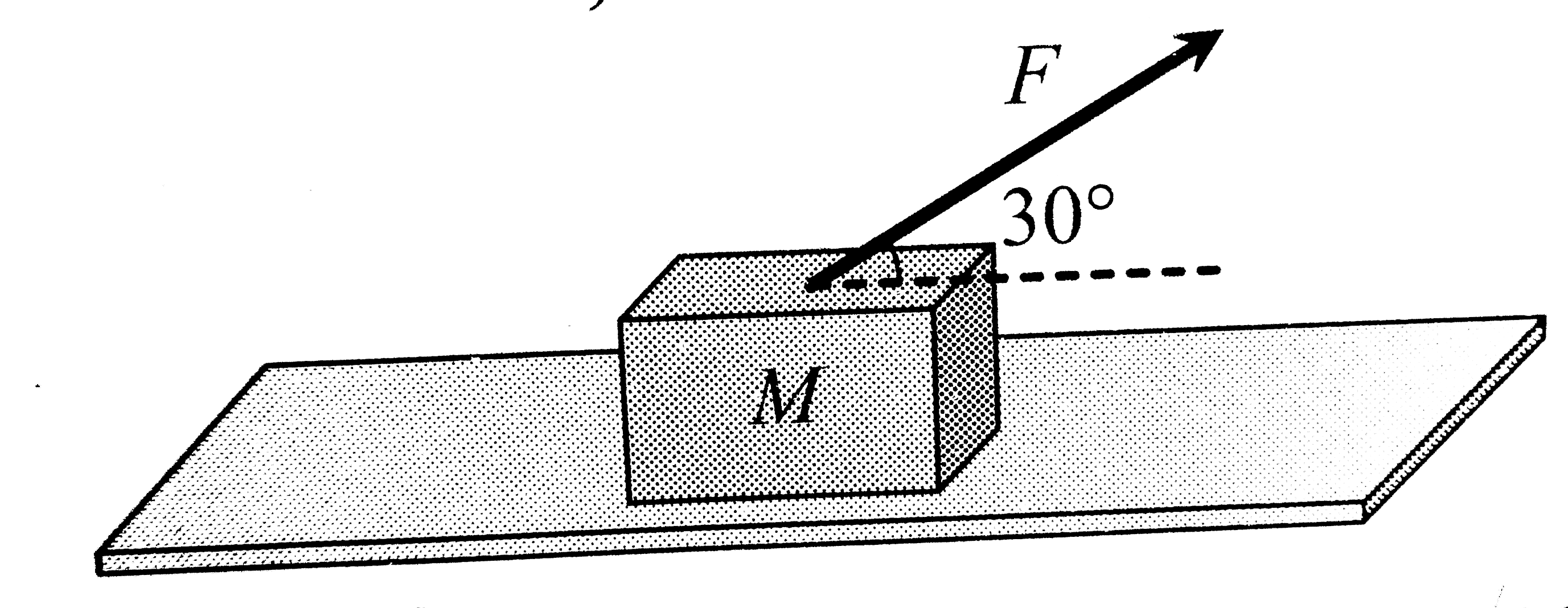A block of mass m=3kg is resting over a rough horizontal surface having coefficient of friction μ=1/3 The block is pulled to the right by appliying a force F inclined at angle 37∘ with the horizontal as shown in fig .The forceincreases with time according to law F=2r newton Calculate its velocity v at t=10s(g=10ms−2)

The correct Answer is:253ms−1
At initial moment (r=0) the force of F=2t=0 it mean no force is acting on the block and the force F increases gradually with time Therefore the friction will come into existence and it will come time existence and it will keep the block in static equlibruim till limiting equilibrium is reached let the come to limiting equilibrium at t=t0 then FBD at that moment will be as shown in fig.
N+2l0sin37∘=mg
For horizontal equilibrium.
μN=2t0cos37∘ .
, Solving equation (i) and (ii)
N=24 Newton and t0=5sec
At t=t0 block is in limiting equilibrium hence just after this moment it will start to slip over the surface threefour at t>t0 the FBD of the block will be as shown in figure for vertical equilibrium

N+2tsin37∘=mg
In horizontal direction it will acceleration
2tcos37∘−μN=ma
From Eqs(iii) and (iv) a=13(2t−10)
, But accfeleration a=dv/dt Therefore
dv=a,d=13(2t−10)dt
Integrating above equation with the condition with the conditions that at t=5sv=0 and at t=10st=?
∫10dv=∫10513(2T−10).dt⇒v=253ms−1
Topper's Solved these Questions
- BOOK - CENGAGE PHYSICS ENGLISHCHAPTER - NEWTON'S LAWS OF MOTION 2EXERCISE - Single Correct87videos
NEWTON'S LAWS OF MOTION 2
- BOOK - CENGAGE PHYSICS ENGLISHCHAPTER - NEWTON'S LAWS OF MOTION 2EXERCISE - Multiple Correct2videos
NEWTON'S LAWS OF MOTION 2
- BOOK - CENGAGE PHYSICS ENGLISHCHAPTER - NEWTON'S LAWS OF MOTION 2EXERCISE - Exercise 7.327videos
NEWTON'S LAWS OF MOTION 2
- BOOK - CENGAGE PHYSICS ENGLISHCHAPTER - NEWTON'S LAWS OF MOTION 1EXERCISE - Integer5videos
NEWTON'S LAWS OF MOTION 1
- BOOK - CENGAGE PHYSICS ENGLISHCHAPTER - PROPERTIES OF SOLIDS AND FLUIDSEXERCISE - INTEGER_TYPE2videos
PROPERTIES OF SOLIDS AND FLUIDS
Similar Questions
A block of mass m=5kg is resting on a rough horizontal surface for which the coefficient of friction is 0.2 . When a force F=40N is applied, the acceleration of the block will be (g=10m/s2) .
 View Solution
View SolutionA block of mass 10kg is placed on a rough horizontal surface having coefficient of friction μ=0.5 . If a horizontal force of 100N is acting on it, then acceleration of the will be.
View Solution
Knowledge Check
- Question 1 - Select One
A block of mass 10kg is placed on a rough horizontal surface having coefficient of friction μ=0.5 . If a horizontal force of 100N is acting on it, then acceleration of the block will be.
A10ms−2B5ms−2C15ms−2D0.5ms−2
A block of mass 10kg is placed on a rough horizontal surface having coefficient of friction μ=0.5 . If a horizontal force of 100N is acting on it, then acceleration of the will be.
View SolutionA block of mass 10kg is placed on a rough horizontal surface having coefficient of friction μ=0.5 . If a horizontal force of 100N is acting on it, then acceleration of the block will be.
View SolutionA block of mass 5kg is lying on a rough horizontal surface. The coefficient of static and kinetic friction are 0.3 and 0.1 and g=10ms−2 The frictional force on the block is
View SolutionA block of mass m is placed at rest on a horizontal rough surface with angle of friction ϕ. The block is pulled with a force F at an angle θ with the horizontal. The minimum value of F required to move the block is
View SolutionA block of mass m is placed at rest on a horizontal rough surface with angle of friction ϕ. The block is pulled with a force F at an angle θ with the horizontal. The minimum value of F required to move the block is
View SolutionA block of mass M rests on a rough horizontal surface as shown. Coefficient of friction between the block and the surface is μ. A force F=mg acting at angle θ with the vertical side of the block pulls it. In which of the following cases the block can be pulled along the surface?
 View Solution
View SolutionA block of mass 10 kg is placed on a rough horizontal surface of coefficient of friction 0.1. A pulling force of 100 N acts on it at 37∘ with the horizontal. The frictional force acting on the body is ..... N.
View Solution

